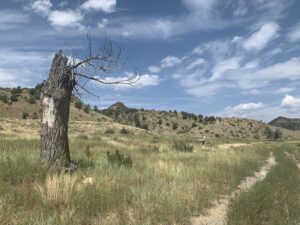SUBSCRIBE!
for updates to my blog
and to my events schedule
Looks like the next chapter in the extraordinary history of Dawson will have to wait.
The purchase of the Dawson Elk Valley Ranch by The Nature Conservancy and several partners, announced with much fanfare back in December, is off – at least for now.
The reason?
Some uncertainty with the status of the $50 million grant awarded by the U.S. Forest Service to the New Mexico Energy, Minerals and Natural Resources Department last year to be used toward the purchase of what used to be the coal town of Dawson.
While the Forest Legacy Program grant agreement has been signed and funds have been committed, it appears there are still concerns over whether the money could be rescinded as part of the federal budget process playing out in Washington.
“Whether the grant can still be rescinded by the federal government is an open question,” said Carol Bada, Forest Legacy Program state coordinator for the New Mexico Forestry Division. “To date, EMNRD has not received any communication about rescission. That does not mean it is not possible at a future date.”
Here is a link to my full story that appeared this morning (June 10) in the Albuquerque Journal.
Blog Archive
In early September, I received an email from Sharon Niederman asking if I would be willing to meet with her to talk about the upcoming release of my book, Crosses of Iron: The Tragic Story of Dawson, New Mexico, and Its Twin Mining Disasters. Naturally, I said “yes,” and we met a few days later…
Read MoreNow that we’re within a few weeks of the Oct. 1 release of Crosses of Iron, I want to call your attention to a few words that appear in the Acknowledgments section at the back of the book. There you will find an expression of my heartfelt gratitude to the Dawson community for its encouragement…
Read MoreOn Tuesday afternoon, Italians will gather at a church in the Province of Modena to observe the National Day of the Sacrifice of the Italian Workers in the World. And when they do, the Dawson mine disasters of 1913 and 1923 will be a key part of it. That’s because Manlio Badiali, a Pompeano resident…
Read More“Over One Million Tons of Coal Produced From Dawson Mines During the Year 1923” “Dawson Boy Scouts Build New Club House” “Dawson Schools Rank with Best in the State” These were among the headlines that appeared in a pictorial supplement issued in the spring of 1924 by The Dawson News, the town’s weekly newspaper. While more company-run house…
Read MoreWhen I began to work on Crosses of Iron, I knew there would be some aspects of the story that would require a lot of time to piece together. The peak population of Dawson wasn’t one of them.Not only was I mistaken, but even now, with the book only months from its October release, I…
Read MoreDawson Cemetery wasn’t the only setting in February to remember the 120 men killed in the mine disaster of 1923. Across the Atlantic, some 5,500 miles away, the 100-year anniversary of the deadly explosion was marked by stories and photographs in Italian newspapers, including a major daily serving the province of Modena in northern Italy. The…
Read More“God bless their souls. May their memories be eternal.” With that, Bishop Constantine of the Greek Orthodox Metropolis of Denver concluded a solemn memorial service to mark the 100-year anniversary of the Feb. 8, 1923, mine disaster under sunny skies and springlike temperatures at historic Dawson Cemetery. One hundred and twenty miners lost their lives in…
Read MoreThe news item couldn’t have been more innocuous. Thomas Brown and David Murphy of Dawson, N.M., who were in Albuquerque Monday, left for home by automobile yesterday. That snippet appeared in the Albuquerque Morning Journal on Feb. 27, 1918, sandwiched between word that Texas cattleman U. Keen was in town for a few days and…
Read MoreFor first-graders from the Forrester Elementary School in Springer, New Mexico, this was no ordinary field trip. Teachers Genevieve Hoskins and Zella Young had something more imaginative in mind for their young charges that day than a traditional visit to a historical site or museum: A once-in-a-lifetime opportunity to make some history of their own.…
Read MoreGhost town or a town of ghosts? When I began my research for an upcoming book about Dawson, New Mexico, my sole focus was on the former. After all, the earthbound story of the old mining town was scary enough: Two massive mine explosions 10 years apart. Nearly 400 men killed between them, the first…
Read MoreIndustrial history was made yesterday at Bruceton. So began a front-page story in The Pittsburgh Post on Oct. 31, 1911, describing in painstaking detail the first public demonstration inside the U.S. government’s new Experimental Mine in Bruceton, Pennsylvania. Its purpose? To determine once and for all whether coal dust – in a mine absent of…
Read MorePoor Frank Hinds never saw it coming. A longtime engineer for the El Paso & Southwestern Railroad, Hinds had no reason to suspect anything but a routine run when he pulled out of Dawson with carloads of coal ticketed for his hometown of Tucumcari. After all, trains had been making this 132-mile trip over the…
Read MoreFor Celestino Vincioni, selling grapes to mining camps during the early years of Prohibition must have felt like taking candy from a baby. Solicit orders for grapes. Deliver grapes. Collect payment for grapes. Repeat. What could possibly go wrong? Quite a bit, as it turns out, starting with a minor arrest that remarkably ascended to…
Read MoreFor Dawson’s shot firers, nothing seemed amiss the night of April 14, 1920. The men entered mine Nos. 1, 2, 3, and 6. They set their explosives. They exited to await detonation by an electric shot-firing system. All in accordance with company rules; all in accordance with New Mexico mine regulations. So how did five…
Read MoreWho hasn’t heard the expression “a canary in a coal mine”? Today, the phrase generally refers to a person or object equipped to detect danger at the earliest possible moment. But not long ago the words held a more literal meaning, reflecting the use of canaries in coal mines to detect whether the air was…
Read MoreFor a New Mexico coal town forever linked to two of the deadliest mine disasters in the nation’s history, Sept. 28, 1907, is remembered as a much happier occasion. On that night, 1,000 people –– 20 to 25 percent of the town’s population – came out to patronize a new business venture in downtown Dawson.…
Read MoreDozens of men working underground. A raging fire. A sudden explosion. Noxious fumes. The mine sealed shut for 12 days. Much is known about the mine disasters of 1913 and 1923 in Dawson, New Mexico. A combined 383 men – mostly immigrants from Europe – died in two violent explosions, the 263 lost in the…
Read MoreThe most spectacular crime in the history of Dawson, New Mexico, had it all – even if it didn’t actually take place in Dawson. Masked bandits. Bound and gagged guards. Exploding safes. Sledgehammers. Quick getaways. Ex-Rough Riders. Multiple arrests. And, as described by one newspaper, “one of the most daring hold-ups ever attempted by desperate…
Read MoreAngelo. Beniamino. Carlo. Dom. Egisto. Geriomine. Luigi. Petro. Pit Della. Raymondo. All emigrants from the same village in Italy. All coal miners. All among the 263 killed in the horrific Oct. 22, 1913, mine explosion in Dawson, New Mexico. All with the same family name: Santi. Ten in all. Of the 146 Italian miners to…
Read MoreThe unpaved roadway leading from State Road 505 to Dawson Cemetery, to be kind, is pretty remote. No businesses. No homes. No people. Not that I was surprised. I had read enough stories, seen enough photographs, and watched enough videos to prepare myself for my first visit to the historic cemetery, Or so I thought.…
Read MoreCrosses of Iron
by Nick Pappas
Now available to order from:
University of New Mexico Press
… and other booksellers.
Audiobook version available to order from …
… and other audiobook sellers.


